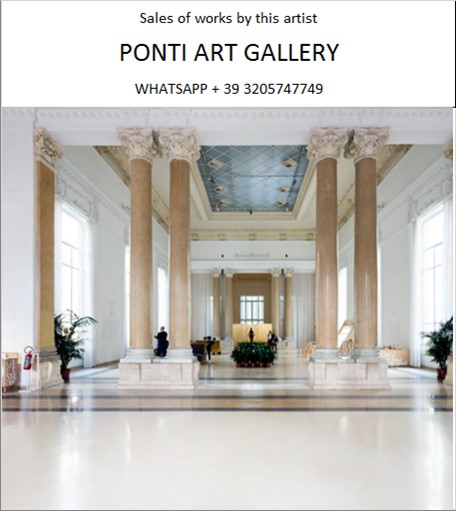Ponti Art Gallery is interested in buying and selling works
of art by this artist.

Elaine Sturtevant Biography
Elaine Frances Sturtevant, known professionally as Sturtevant, was an American artist whose work challenged the very notions of originality, authorship, and the creative process. Born on August 23, 1924, in Lakewood, Ohio, near Cleveland, Sturtevant's journey into the art world was as unconventional as her work would come to be known.
Sturtevant earned a bachelor's degree in psychology from the University of Iowa, followed by a master's degree in the field from Teachers College of Columbia University. Her academic pursuits in psychology would later inform her artistic practice, which delved into the depths of perception and recognition. In New York, she also studied at the Art Students League, further honing her skills and understanding of art.
In the late 1950s, Sturtevant began her artistic career with paintings that involved slicing open tubes of paint, flattening them, and attaching them to canvas. These early works, which contained fragments from tubes of several colors of paint, sometimes accompanied by pencil scribbles and daubs of paint, were a prelude to her more renowned conceptual pieces.
Sturtevant's groundbreaking approach to art came to the fore in 1964 when she began to manually reproduce—or "repeat"—paintings and objects created by her contemporaries. She focused on works by prominent American artists such as Roy Lichtenstein, Frank Stella, Claes Oldenburg, Jasper Johns, James Rosenquist, and Andy Warhol. Her process involved memorizing the original works and replicating them by hand, employing the same techniques as the original artists. This method of working from memory and by hand introduced subtle differences that became a hallmark of her practice.
One of the most famous anecdotes about Sturtevant involves Andy Warhol, who, when asked about his own technique, reportedly said, "I don't know. Ask Elaine." Warhol even gave Sturtevant one of his silkscreens so she could produce her own versions of his Flowers paintings. This act of sharing not only tools but also techniques was a testament to the mutual understanding and respect between Warhol and Sturtevant regarding the exploration of authorship and originality.
Sturtevant's work was not about forgery or mere imitation; it was a deep inquiry into the power structures behind art. By replicating iconic works, she questioned what made an artwork original and valuable. Her work suggested that if one borrows an image that is itself borrowed, then perhaps neither is truly original. This was a radical stance at a time when the art world was preoccupied with the idea of the "authentic" work of art.
Despite her innovative approach, Sturtevant faced challenges in gaining recognition. She experienced periods of withdrawal from the art scene, notably in the mid-1970s to the mid-1980s. However, she re-emerged in 1986 with a show at White Columns in Lower Manhattan, and her work began to receive the critical attention it deserved.
In the later years of her career, Sturtevant turned increasingly to video and installation art, producing works that reflected on the pervasive nature of our image-saturated culture. Her video installations often incorporated footage shot directly off her television set, commenting on the fragmented and repetitive nature of contemporary media.
Sturtevant's influence extended beyond her lifetime, with her work being the subject of major museum shows around the world, including the Museum für Moderne Kunst in Frankfurt, the Moderna Museet in Stockholm, and the Museum of Modern Art in New York. She was awarded the Golden Lion for lifetime achievement at the Venice Biennale in 2011, and her work continued to provoke and inspire long after her death on May 7, 2014, in Paris, where she had made her home since the early 1990s.
Sturtevant's legacy is that of an artist who was ahead of her time, whose work presaged contemporary discussions about appropriation, meme culture, and the digital age's impact on authorship and originality. Her work remains a powerful commentary on the art world and continues to challenge viewers to think critically about the nature of creativity and the meaning of art.
Elaine Sturtevant Quotes and
Sales of Works
Ponti Art Gallery selects and deals with paintings by the
artist. Upon request, we provide free estimates and
evaluations, communicate prices, quotations, and current
market values.
If you are interested in BUYING or SELLING works by the
artist, contact us immediately.
If you wish to sell or receive an evaluation of the
works:
Send us a frontal photo of the painting, one of the back,
and one of the signature. Also, indicate the dimensions of
the work. Inform us about the purchase origin of the work
and any kind of available documentation (purchase
receipts, certificates of authenticity, publications). One
of our operators will respond to you on the same day. We
guarantee maximum confidentiality and extreme
professionalism.
If you wish to purchase works by the painter: Contact us
and let us know your request. We will inform you about the
available works. We also offer the possibility to
subscribe to our NEWSLETTER, through which you will be
informed at the beginning of each month about the latest
acquisitions of the art gallery.
You can send us pictures of the work:
